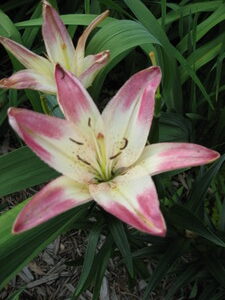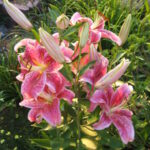If you ever thought that lilies were just too exotic and, therefore, too difficult to grow, perhaps you should try growing some Asiatic lilies. I believe that you will be pleasantly surprised by the Asiatic lily.
Lilies have had a reputation for not having a very long lifespan in the garden and for being constantly assailed by viruses; i.e., botrytis and fusarium. Hybridizers, beginning with Cornelius de Graaf in Holland in 1790, set about trying to develop a hardier and more disease-resistant lily. One of the results of this hybridizing effort pursued by numerous lily enthusiasts around the world was the development of the Asiatic lily. The driving force behind this effort was Jan de Graaf, great-grandson of Cornelius, at Oregon Bulb Farms. In the 1930s and 1940s, de Graaf gathered as many different hybrid bulbs from as many different places around the world as he possibly could. Over the decades, he worked at developing hardier lilies, including the influential orange ‘Enchantment.’ To make a long story short, the Asiatic lily was born.
Asiatic lilies constitute a large group of hybrids and are grown more widely around the world than any other types of lilies. Asiatic lilies make stunning cut flowers and come in a wide array of colors and color combinations. They are virtually pest- and disease-free and are extremely hardy. (I have heard accounts of people growing Asiatics as far north as Zone 2.) They are also quite sturdy and do not require staking. Asiatic lilies are often confused with Oriental lilies; however, Asiatics are short to medium height, while Oriental lilies are much taller. Furthermore, Asiatics – unlike Orientals – have no fragrance.
The blooms on Asiatic lilies tend to be large (bowl-shaped, flat, or reflexed) and grow close together on the stem. The flowers can be upright, outward-facing, or pendant. Some blooms have freckling, while others have brush marks. Thanks to numerous hybridizers, Asiatic lilies can be found in colors from white and pink to yellows, oranges, and reds to almost black.
Plant your Asiatic lilies in a sunny location where they can get a bit of dappled sun during part of the day. They like their roots to be cool, which means they do well when planted with other perennials that can shade your lily’s roots. Asiatic lilies do need some protection from the wind. They also like well-drained, humus-rich soil. I have noticed that my Asiatic lilies really start coming into their own in about their second year and then just keep getting better with each successive year. As with all lilies, do not cut back the stalks after the blooms are spent. Instead, allow the leaves and stems to die back naturally; because this is how the bulbs gather nutrients for the next year. In my Zone 6 area, I have found no need to lift the bulbs in the fall; however, I have heard that gardeners much further north do lift the bulbs. (If you decide not to lift your bulbs, be sure to mulch them well in the fall.)
Do not let the exotic beauty of the Asiatic lily lead you to believe that you cannot grow these beautiful lilies. Asiatic lilies are actually the easiest lilies to grow.
Try some of the following cultivars in your garden:
1.’Lollipop’ (white and pink and extremely popular)
2.’Enchantment’ (orange)
3.’Vivaldi’ (pink)
4.’Gran Paradiso’ (red)
5.’Connecticut King’ (yellow)
6.’Black Out’ (dark red)
7.’Shirley’ (pink and white)
For examples of more Asiatic lilies, see: Dave’s Garden
Also of interest: McGeorge, Pamela. Lilies. New Zealand: Firefly Books Ltd., 2004.
To see some of the lilies in my garden, visit: Dena’s Garden





